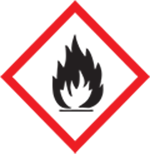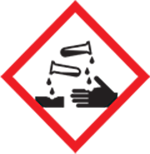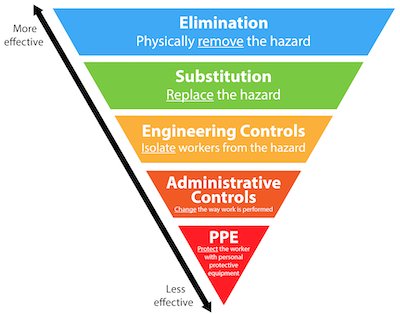Acetic Anhydride
This chemical standard operating procedure (SOP) and the associated Safety Data Sheet (SDS) are for our safety. Read and understand both documents. If this is a paper copy, check for updated versions on the IsoLab website.
Process
Acetic anhydride AND Mercaptoacetic acid are both used to make the resin for selectively extracting selenium from solutions for later isotopic analyses. The preparation of the resin involves (1) soaking commercial cotton balls in both of these acids for 5 days at 40C, (2) then filtering the cotton and washing it with DI water. (3) The residual acids are collected in a waste container.
Hazards - SDS



Acetic anhydride is a flammable liquid and vapor, is harmful if swallowed, causes severe skin burns and eye damage, and is fatal if inhaled.
Protection - SDS

Engineering Controls
Acetic anhydride may be used in any of the fume hoods located in the 302 / 303 suite. Do not open the bottle outside of a fume hood. Ensure the fume hood has proper air flow by checking the flow rate on the control panel and / or using a smoke match or wipe to visualize flow.
PHS - While it would be best to use the fume hood directly above the storage cabinet in 302B because this limits transport of the bottle, any fume hood in the 302/303 suite will be fine.
Administrative Controls
PHS - Tell others in the lab that you are using acetic anhydride. Do not allow anyone else to work in the same fume hood while you are working with acetic anhydride unless they are working with you. If you must leave the fume hood for any period of time, close the sash and tape a sign up indicating the presence of acetic anhydride.
Personal Protective Equipment (PPE)
Wear a flame retardant antistatic laboratory coat (these are the purple lab coats in the drawers on the west wall of 303B), nitrile gloves, and tightly fitting safety goggles while working with acetic anhydride.
Handling - SDS
Keep container tightly closed when not in use. Keep away from heat, sparks, open flames, and hot surfaces. Make sure you have your laboratory coat, eye protection, and gloves on before handling the bottle.
PHS - Decontamination - Acetic anhydride reacts with water to form acetic acid. Our current use of acetic anhydride necessitates mixing with water. Expect and prepare for the presence of acetic acid.
Storage - SDS
In general, acetic anhydride must be stored in a flammables cabinet under a fume hood. Use MyChem, the UW EH&S chemical inventory database, to find exactly where in the IsoLab suite this chemical should be stored. Store at room temperature and in the provided secondary containment within the flammables cabinet.
Spills - SDS
If there is an imminent threat of a fire, pull the nearest fire alarm station to evacuate the building and dial 911. If personnel have become exposed and need medical assistance, dial 911.
PHS - Exposure:
- Inhalation - If you have inhaled acetic anhydride fumes, move to fresh air. For advice, call UW Employee Health Center (206.685.1026) or the Washington Poison Center (800.222.1222). For emergency help, call 911. If breathing stops: immediately apply artificial respiration, if necessary also oxygen.
- Skin contact - In case of skin contact, remove all contaminated clothing. Rinse skin with water / shower. For advice, call UW Employee Health Center (206.685.1026) or the Washington Poison Center (800.222.1222). For emergency help, call 911.
- Eye contact - In case of eye contact, rinse out with plenty of water. For advice, call UW Employee Health Center (206.685.1026) or the Washington Poison Center (800.222.1222). For emergency help, call 911. Remove contact lenses.
If the spill is fully contained inside the fume hood, close the sash and prepare yourself to clean it up. Grab the closest spill kit. Make sure you have the appropriate PPE on (lab coat, nitrile gloves, eye protection). Do not allow the substance to enter the drain. Use liquid-absorbent material to soak up the chemical. Put all generated waste into a bag. See Waste section below.
If the spill is outside of the hood, do not breathe vapors and ensure adequate ventilation. Do not let anyone enter the contaminated space until the air is cleared or proper PPE has been donned.
If you need assistance or advice, use the IsoLab Emergency Contacts sheet.
Consult the EH&S Spill Poster and Exposure Poster
Waste - SDS
If you are cleaning up after a spill and have a bag of debris, ensure the bag is sealed and use multiple bags as needed. Complete an EH&S Hazardous Waste Label and adhere it to the bottle. Here are instructions for how to label chemical waste containers. Labels are located in a drawer on the west wall of 303B near the door to the hallway.
Acetic anhydride should never go down the drain. If you are cleaning up after routine work, put all waste, solid or liquid, into a plastic wide mouth container. Options for waste containers can be found under the west sink in 303B. Complete an EH&S Hazardous Waste Label and adhere it to the bottle. Here are instructions for how to label chemical waste containers. Labels are located in a drawer on the west wall of 303B near the door to the hallway.
Place the properly labeled container in one of the gray tubs near the hallway door of 303B. Segregate from other waste containers as appropriate.
Consult our generalized Chemical Waste Disposal SOP.

Training
Acetic anhydride is deemed a particularly hazardous substance - PHS by EH&S and you need approval before using it. Complete the list of requirements below before using this chemical.
Prerequisites
- You must have completed Managing Laboratory Chemicals in the last three years. Login to check.
- Read and understand the SDS for acetic anhydride.
- Read, understand, and digitally sign this SOP.
- Contact your Principal Investigator (PI) AND the Chemical Hygiene Officer (CHO) indicating that you have completed all prerequisites and await approval.
